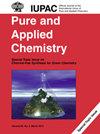使用酰肼或环烯的 Cu(II) 复合物用于杀菌防污涂料
IF 2
4区 化学
Q3 CHEMISTRY, MULTIDISCIPLINARY
引用次数: 0
摘要
铜和铜基化合物具有广谱抗菌活性,但由于人们担心铜会渗入环境并对非目标生物产生毒性,因此铜基涂料的使用受到了限制。我们的目标是开发出既能利用铜的杀菌活性,又能通过减少铜对环境的沥滤来降低负面影响的涂料。本研究报告介绍了铜配位体的合成和表征、铜配位体在涂料中的配制以及铜配位体抗菌活性的测试。研究人员合成了一种多酰基腙和一系列简单的酰基腙,并与铜(II)配位,但由于它们的水溶性较差或铜的沥滤水平较高而被认为不合适。另一种方法是成功地将铜螯合到四氮杂环--环烯上,并利用环烯合成出铜(II)-环烯官能化二氧化硅颗粒,成功地将其与商用涂料配方结合在一起。当这些功能化产品与环氧树脂涂料结合时,显示出很差的抗菌活性,这可能是由于配方中的铜含量较低。不过,这些配体可能还有其他用途,例如去除受污染污水中的重金属。本文章由计算机程序翻译,如有差异,请以英文原文为准。
Cu(II) complexes using acylhydrazones or cyclen for biocidal antifouling coatings
Copper and copper-based compounds have broad spectrum antimicrobial activity, but concerns about leaching into the environment and toxicity on non-target organisms is leading the use of copper-based coatings being restricted. Our objective was to develop coatings that used the biocidal activity of copper, but with low negative impacts by reducing its leaching into the environment. This study reports the synthesis and characterisation of copper coordinating ligands, their formulation into coatings and testing of their antibacterial activity. A polyacylhydrazone and a series of simple acylhydrazones were synthesised and coordinated to Cu(II), but were considered unsuitable due to either their poor water-solubility or high levels of copper leaching. In an alternative approach, copper was successfully chelated to the tetraazamacrocycle, cyclen, and used to synthesise Cu(II)-cyclen functionalised silica particles, which were successfully combined with commercial paint formulations. These functionalised products showed poor antibacterial activity when incorporated into epoxy coatings, probably due to the low copper content of the formulations. However, these ligands may have other applications, such as removal of heavy metals from contaminated effluent steams.
求助全文
通过发布文献求助,成功后即可免费获取论文全文。
去求助
来源期刊

Pure and Applied Chemistry
化学-化学综合
CiteScore
4.00
自引率
0.00%
发文量
60
审稿时长
3-8 weeks
期刊介绍:
Pure and Applied Chemistry is the official monthly Journal of IUPAC, with responsibility for publishing works arising from those international scientific events and projects that are sponsored and undertaken by the Union. The policy is to publish highly topical and credible works at the forefront of all aspects of pure and applied chemistry, and the attendant goal is to promote widespread acceptance of the Journal as an authoritative and indispensable holding in academic and institutional libraries.
 求助内容:
求助内容: 应助结果提醒方式:
应助结果提醒方式:


